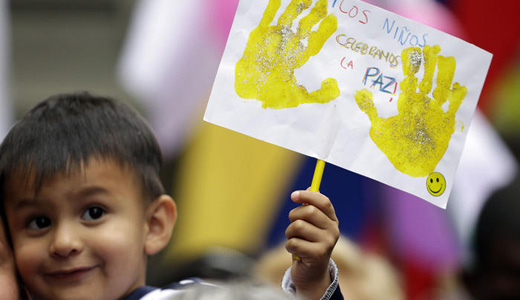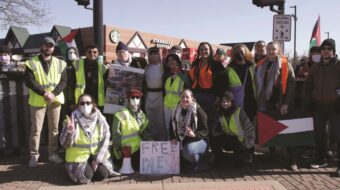
The media and commentators used expressions like “An historic step,” “Good bye to war,” or “Last day of the war” to explain why the signing June 23 of an agreement on peace in Colombia warranted a celebratory gathering in Havana, Cuba. Negotiators for the Colombian government and the Revolutionary Armed Forces of Colombia – People’s Army (FARC-EP) have been working there for almost four years. They had ploughed through four agenda items and now had reached agreement on one more. But it was the last one needed before a final agreement could be signed and before a war lasting 52 years could be ended.
Negotiators had registered agreement on agrarian reforms, illegal drugs, political participation for the guerrillas, and “victims” – making amends and punishing perpetrators. Now they were finished with the “End of Conflict” part. Observers see a final agreement signed within two months, and in Colombia.
The multi-faceted agreement signed June 23 covers: the hand-over of arms by the insurgents; preparation of guerrillas for entry into civilian life; protection of their security through removing deadly threats posed by paramilitaries; and the Colombian people’s endorsement of the final agreement. Elements of this agreement merge with those of a sixth agenda item, which is ‘Implementation, verification, and endorsement.”
Cuban President Raul Castro that day presided over an emotionally- charged assembly at which Colombian President Juan Manuel Santos and FARC leader Timoleón Jiménez signed the agreement. Representatives of two guarantor countries, Cuban diplomat Rodolfo Benítez and Norwegian Foreign Minister Borge Brende did likewise as did the representatives of the “accompanying countries,” Chilean President Michelle Bachelet and Venezuelan President Nicolás Maduro. Special guests included Danilo Medina, president both of the Dominican Republic and the CELAC regional alliance, President Salvador Sánchez Cerén of El Salvador, Mexican President Enrique Peña Nieto, and special envoys Bernard Aronson and Eamon Gilmore of the United States and European Union, respectively.
Speaking at the gathering, United Nations Secretary General Ban Ki-Moon lauded Colombia’s peace process as validating the “perseverance of all those … who work to end violent conflict not through the destruction of the adversary, but through the patient search for compromise.” As requested by the negotiating teams, the United Nations Security Council had earlier approved a political mission of international observers to be in Colombia to monitor and verify the process of disarming the FARC – EP.
The agreement on “end of conflict” calls for each FARC guerrilla to be transferred to one of 23 “vereda”- sized “zones” located throughout the country, or to one of eight 10 – acre – size encampment areas. (A “vereda” is Colombia’s smallest territorial administrative unit.) This will happen within five days of the signing of a final agreement. The purpose of the zones is “to guarantee the bilateral and definitive ceasefire and end of hostilities and the handing over of arms, and to begin the process of reincorporation [of FARC combatants] into civilian life.”
The U.N. mission will be working in these zones, assisted by FARC and Colombian Army personnel and observers from the Community of Latin American and Caribbean States (CELAC). The teams will destroy “unstable” FARC military equipment and catalogue, process, and store the rest. Arms will end up in containers whose keys stay with U.N. personnel. A 1km-wide security area will surround each zone, with access being controlled by the Mission.
Meanwhile, FARC members will be preparing to enter civilian life; schooling will be provided, if needed. What happens in the zones will take place over 150 days. After that, over the next month, former FARC fighters will be leaving to rejoin civilian life. The zones will disappear and a “bilateral and definitive end to hostilities“ will follow.
Joint Communique No. 76, issued by the negotiating teams on June 23, provides voluminous information on the agreement. Of special note are plans for “implementing measures necessary for intensifying actions against organizations and criminal behaviors threatening the construction of peace.” The reference is to steps proposed for countering the paramilitary threat. Paramilitaries had previously slaughtered FARC combatants once they were civilians. They’ve violently assaulted members of Colombia’s social movements and political opposition groups.
Provisions of the agreement take effect within five days of the signing of a final agreement, which needs to be endorsed by the Colombian people. The negotiators determined that a plebiscite would suffice for that purpose, although FARC negotiators had called for a constituent assembly. Colombia’s Constitutional Court is preparing to rule on the legitimacy of endorsement through a plebiscite.
News reports say the Court’s decision will come approximately a month after a final agreement is signed. How the agreement on “end of conflict” will be implemented if the plebiscite fails is unclear.
On learning June 22 that the civil war would soon be ending, demonstrators filled streets in Bogota and other cities. According to Prensa Latina, the Patriotic March coalition of social and political movements is preparing for a national mobilization – a “people’s fiesta” – in July to celebrate the coming of peace and to build support for the plebiscite. There will be a national march on July 15.
The prensarural.org (or “rural press) news service, sympathetic to the cause of marginalized rural peoples, wrote in an editorial that “the dreams of hundreds of small farmers who took up arms – [the FARC, that is] – will be a reality now: a new and inclusive Colombia where confrontation will be with ideas and with social struggles through social mobilization and community empowerment.”
Carlos Lozano, director of the Communist Party’s Voz weekly newspaper, pointed out that, “The state must change its ways and adjust to new democratic conditions of the post-conflict era. It will have to accept the opposition and also questioning of the status quo, as allowed by the Constitution. It must abandon the exercise of power through violence.”
Mexico’s La Jornada news service warned of “a most dangerous stage ahead” for the peace process. The editorialist was thinking of “provocations [instigated] by the principal beneficiaries of the violence – ex- President Alvaro Uribe and paramilitary groups he is associated with and some recalcitrant sectors of the traditional oligarchy and the top military commanders.”
These commentators and others pointed out that war still may not be ending in Colombia, even after the FARC demobilizes; this is because the government’s talks with guerrillas of the National Liberation Army (ELN) have stalled.
The subject at hand is a war that took over 200,000 lives, displaced six million rural inhabitants, created 9000 political prisoners, led to serious repression within Colombian society, has 450,000 Colombian soldiers and police under arms now, swallowed up $10 billion in U.S. taxpayer money since 2000, and attracted seven U.S. military bases.
Surely, one supposes, news about that war’s coming demise is “fit to print,” as per the famous New York Times slogan.
However, the Times in reporting the June 23 event in Havana – attended by the presidents of seven countries – saw fit to print only 51 words the next day. They showed up as the caption accompanying three images appearing on page seven.
Photo: A boy holds a sign that reads in Spanish “children celebrate peace” during celebrations over the agreement. | Fernando Vergara/AP












Comments